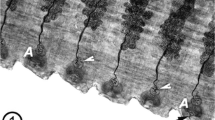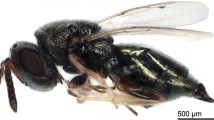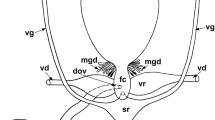Summary
The structure of the organs taking part in oviposition of Thripidae (ovipositor, ectodermal exit system, spermatheca, accessory gland) has been investigated by light- and electron microscopy. Some histochemical tests were also performed.
The general structure of the ovipositor corresponds to that known for other pterygote insects, except for a few pecularities, e.g. the absence of third valvulae (or gonapophyses IX).
The spermatheca is a thin-walled vesicle consisting of wall cells and single gland cells. It is connected to the vagina by socle cells containing a well-developed system of infoldings of the apical plasma membrane. The spermathecal duct has a valve. The sperm ball in the spermathecal lumen is surrounded by an enveloping structure. Several authors have categorized it as a spermatophore, a problematic interpretation in some respects.
The accessory gland is a typical ectodermal insect gland, which probably produces a mucoprotein secretion as a lubrication and/or cementing agent for oviposition. The ultrastructure of the gland cells depends on the maturity stage of the animal. The accessory gland duct is also provided with a valve.
A hypothesis concerning the mechanical function of the oviposition apparatus as well as some cytological observations are discussed; and the structure of the Thripid ovipositor is compared with that in other Pterygota.
Zusammenfassung
Der Aufbau der an der Eiablage beteiligten Organe der Thripiden (Ovipositor, ektodermale Geschlechtswege, Spermathek, Anhangsdrüse) wurde mit light- und elektronenmikroskopischen Methoden einschließlich einiger histochemischer Nachweise untersucht.
Der Grundaufbau des Ovipositors entspricht dem bei anderen pterygoten Insekten, abgesehen von einigen Besonderheiten, z.B. dem Fehlen der dritten Valvulae (oder Gonapophysen IX).
Die Spermathek ist eine dünnwandige Blase und besteht aus Wandzellen und einzelnen Drüsenzellen. Sie ist mit der Vagina durch Sockelzellen verbunden, die ein wohlentwickeltes System von Einfaltungen der apikalen Zellmembran enthalten. Der Verbindungsgang zur Vagina besitzt ein Ventil. Der Spermienballen im Lumen der Spermathek ist von einer Hüllstruktur umschlossen. Einige Autoren haben sie als Spermatophore gedeutet, was aber in verschiedener Hinsicht problematisch erscheint.
Die Anhangsdrüse ist eine für Insekten typische ektodermale Drüse und erzeugt vermutlich ein Mucoprotein-Sekret als Schmier- und/oder Kittsubstanz für die Eiablage. Die Ultrastruktur der Drüsenzellen hängt vom Reifegrad des Tieres ab. Der Ausführgang der Anhangsdrüse besitzt ebenfalls ein Ventil.
Es wird eine Hypothese über die mechanische Funktion des Legeapparates entwickelt. Einige cytologische Beobachtungen werden diskutiert, und der Aufbau des Thripiden-Ovipositors wird mit dem anderer Pterygoten verglichen.
Similar content being viewed by others
Abbreviations
- Adr:
-
Anhangsdrüse
- Ag:
-
Ausführgang der Anhangsdrüse
- AM:
-
Apikale Membraneinfaltungen der Sockelzellen der Spermathek
- Ap:
-
Apodem
- aS:
-
Amorphe Substanz unter der Intima der Spermathek
- Bm:
-
Basalmembran
- Bv1:
-
Basivalvula 1
- Bv2:
-
Basivalvula 2
- C:
-
Sinnescilium
- D:
-
Darm
- dR1:
-
Dorsaler Ramus der 1. Valvula
- dR2:
-
Dorsaler Ramus der 2. Valvula
- Dz:
-
Drüsenzelle
- Ep:
-
Epiproct
- ER:
-
(granuläres) Endoplasmatisches Reticulum
- Fk:
-
Fettkörper
- G:
-
Golgi-Apparat
- Gk:
-
Genitalkammer
- I:
-
Intima
- Kz:
-
Kanalzelle
- L:
-
Lysosom
- Ln:
-
Längsnervenstrang in der Valvula
- M:
-
Mitochondrium
- Ma:
-
elastische Manschette am Ventil der Spermathek
- MG:
-
Malpighi-Gefäß
- N:
-
Nucleus, Zellkern
- Nm:
-
Nuclearmembran, Kernmembran
- Ode:
-
Oviductus communis
- Op:
-
Ovipositor
- Pg:
-
Pigmentgranulum
- Pg:
-
Paraproct
- Pt:
-
Pleurotergit
- q:
-
quadratische Verstärkungsplatte an der Basis der 1. Valvula
- Rf:
-
Resilinfilz (=„feltwork”)
- Rk:
-
Resilinkappe
- SE:
-
Sekretorischer Endapparat
- Se:
-
Sekret
- Sk:
-
Sekretkanälchen
- Spb:
-
Spermienballen
- Sph:
-
Spermienhülle
- St:
-
Sternum
- Sth:
-
Spermathek
- Stt:
-
Stacheltasche
- Sv:
-
Sekretvakuole
- Sz:
-
Sockelzelle
- T:
-
Tergum
- Tk:
-
Tubularkörper
- V:
-
Ventil
- Vag:
-
Vagina
- Vf:
-
Valvifer
- Vg:
-
Verbindungsgang von der Spermathek zur Vagina
- V1:
-
Valvula
- vR1:
-
Ventraler Ramus der 1. Valvula
- vR2:
-
Ventraler Ramus der 2. Valvula
- Wz:
-
Wandzelle
- x:
-
unpaares medianes Sklerit in der Wand der Genitalkammor
Literatur
Badonnel, A.: Psocoptera. In: Taxonomist's glossary of genitalia in insects, S. L. Tuxen, ed., p. 172–175. Kopenhagen: Munksgaard 1970
Börner, C.: Zur Systematik der Hexapoden. Zool. Anz. 27, 511–533 (1904)
Bournier, A.: Contribution a l'étude de la parthenogenèse des Thysanoptères et de sa cytologic. Arch. Zool. Exp. Genève 93, 219–317 (1956)
Bournier, A.: L'appareil génital femelle de Caudothrips buffai Karny et sa pompe spermatique (Thysanoptera). Bull. Soc. Entom. France 67, 203–207 (1962)
Buffa, P.: Contributo allo studio anatomico della Heliothrips haemorrhoidalis Fabr. Riv. Pat. Veget. Vol. VII N 1,4 1–36 (1898)
Conti, L., Ciofi-Luzzatto, A., Autuori, F.: Ultrastructural and histochemical observations on the spermathecal gland of Dytiscus marginalia L. (Coleoptera). Z. Zellforsch. 134, 65–85 (1972)
Davies, R. G.: The postembryonic development of the female reproductive system in Limothrips cerealium Haliday (Thysanoptera: Thripidae). Proc. Zool. Soc. 136, 411–437 (1961)
Davies, R. G.: The skeletal musculature and its metamorphosis in Limothrips cerealium Haliday (Thysanoptera: Thripidae). Trans. roy. entom. Soc. London 121, 167–233 (1969)
Doeksen, I. J.: Bijdrage tot de vergelijkende morphologie der Thysanoptera. Mededeelingen Landgebouwhoogeschool Wageningen 45, 1–114 (1941)
Dupuis, C.: Heteroptera. In: Taxonomist's glossary of genitalia in insects, S. L. Tuxen, ed., p. 190–209. Kopenhagen: Munksgaard 1970
Handlirsch, A.: Thysanoptera. In: C. Schröder, Handbuch der Entomologie, Bd. III, S. 477–481. Jena: G. Fischer 1923
Hawke, S. D., Farley, R. D., Greany, P. D.: The fine structure of sense organs in the ovipositor of the parasitic wasp, Orgilus lepidus Musebeck. Tissue and Cell 5, 171–184 (1973)
Heming, B. S.: Postembryonic development of the female reproductive system in Frankliniella fusca (Thripidae) and Haplothrips verbasci (Phlaeothripidae) (Thysanoptera). Misc. Publ. entom. Soc. Amer. 7, 197–234 (1970)
Hennig, W.: Die Stammesgeschichte der Insekten. Frankfurt: Kramer 1969
Jones, T.: The external morphology of Chirothrips hamatus Trybom (Thysanoptera). Trans. roy. entom. Soc. London 105, 163–187 (1954)
Jordan, K.: Anatomic und Biologic der Physopoden. Z. wins. Zool. 47, 541–620 (1888
Klier, E.: Zur Konstruktionsmorphologie des männlichen Geschlechtsapparates der Psocopteren. Zool. Jb. Abt. Anat. u. Ontog. 75, 207–286 (1956)
Klocke, F.: Beitrdge zur Anatomic und Histologie der Thysanopteren. Z. wins. Zool., Abt. A, 128, 1–36 (1926)
Liskiewicz, S.: Spermatophores in Chirothrips manicatus Haliday (Thysanoptera: Thripidae). Zoologica Poloniae 10, 329–332 (1960)
Melis, A.: Tisanotteri Italiani: Genus Melanthrips. Redia 20, 1–145 (1933)
Michener, C. D.: Comparative study of the appendages of the eighth and ninth abdominal segments of insects. Ann. entom. Soc. Amer. 37, 336–351 (1944)
Mickoleit, E.: Untersuchungen zur Kopfmorphologie der Thysanopteren. Zool. Jb. Abt. Anat. u. Ontog. 81, 101–150 (1963)
Mickoleit, G.: Zur Thoraxmorphologie der Thysanoptera. Zool. Jb. Abt. Anat. u. Ontog. 79, 1–92 (1961)
Mickoleit, G.: Über den Ovipositor der Neuropteroidea und Coleoptera und seine phylogenetische Bedeutung (Insecta, Holometabola). Z. Morph. Tiere 74, 37–64 (1973)
Müller, H. J.: Über Bau und Funktion des Legeapparates der Zikaden (Homoptera Cicadina). Z. Morph. Okol. T. 38, 534–629 (1942)
Pearse, A. G. E.: Histochemistry, theoretical and applied. London: Churchill 1961
Pesson, P.: Ordre des Thysanoptera. In: Traité de Zoologie, public sous la direction de Grassé, vol. X, fasc. II, p. 1805–1869. Paris: Masson 1951
Priesner, H.: Die Thysanopteren Europas. Wien: Wagner 1928
Priesner, H.: Thysanoptera. In: Kükenthals Handbuch der Zoologie, Bd. IV (2), 2/19. Berlin: De Gruyter 1968
Priesner, H.: Thysanoptera. In: Taxonomist's glossary of genitalia in insects, S. L. Tuxen, ed., p. 209–213 (2. Aufl.). Kopenhagen: Munksgaard 1956/1970
Risler, H.: Der Kopf von Thrips physapus L. (Thysanoptera, Terebrantia). Zool. Jb. Abt. Anat. u. Ontog. 76, 251–302 (1957)
Risler, H., Kempter, E.: Die Haploidie der Männchen und die Endopolyploidie in einigen Geweben von Haplothrips (Thysanoptera). Chromosoma (Berl.) 12, 351–361 (1961)
Romeis, B.: Mikroskopische Technik. München/Wien: Leibniz 1968
Ruthmann, A.: Methoden der Zellforschung. Stuttgart: Franckh 1966
Scudder, G. G. E.: Reinterpretation of some basal structures in the insect ovipositor. Nature (Lond.) 180, 340–341 (1957)
Scudder, G. G. E.: The comparative morphology of the insect ovipositor. Trans. roy. entom. Soc. 113, 25–40 (1961)
Scudder, G. G. E.: Thysanura. In: Taxonomist's glossary of genitalia in insects, S. L. Tuxen, ed., p. 27–29. Kopenhagen: Munksgaard 1970
Sharga, U. S.: On the internal anatomy of some Thysanoptera. Trans. roy. entom. Soc. 81, 185–204 (1933)
Sharov, A. G.: Basic arthropodan stock with special reference to insects. Oxford-New York-Frankfurt: Pergamon Press 1966
Smith, E. L.: Evolutionary morphology of external insect genitalia. I. Origin and relationship to other appendages. Ann. entom. Soc. Amer. 62, 1051–1079 (1969)
Smith, E. L.: Evolutionary morphology of external insect genitalia. III. External genitalia of Euura (Hymenoptera, Tenthredinidae): Sclerites, sensilla, musculature, development and oviposition behaviour. Int. J. Insect Morph. Embr. 1, 321–365 (1972)
Snodgrass, R. E.: Morphology of the insect abdomen. Part I: General structure of the abdomen and its appendages. Smithson. mist. Coll. 85 (6), 1–128 (1931)
Snodgrass, R. E.: Morphology of the insect abdomen. Part II: The genital ducts and the ovipositor. Smithson. mist. Coll. 89 (8), 1–148 (1933)
Phurm, U.: Mechanoreceptors in the cuticle of the honeybee. Fine structure and stimulus mechanism. Science 145, 1063–1065 (1964)
Uzel, H.: Monographie der Ordnung Thysanoptera. Königgrätz 1895
Weber, H.: Grundriß der Insektenkunde. Stuttgart: Fischer 1954
Weber, H.: Stellung und Aufgaben der Morphologie in der Zoologie der Gegenwart. Verb. dtsch. zool. Ges. 18, Suppl., 137–159 (1955)
Wessing, A., Eichelberg, D.: Elektronenoptische Untersuchungen an den Nierentubuli von Drosophila melanogaster. I. Regionale Gliederung der Tubuli. Z. Zellforsch. 101, 285–322 (1969)
Author information
Authors and Affiliations
Rights and permissions
About this article
Cite this article
Bode, W. Der Ovipositor und die weiblichen geschlechtswege der Thripiden (Thysanoptera, Terebrantia). Z. Morph. Tiere 81, 1–53 (1975). https://doi.org/10.1007/BF00290072
Received:
Issue Date:
DOI: https://doi.org/10.1007/BF00290072




